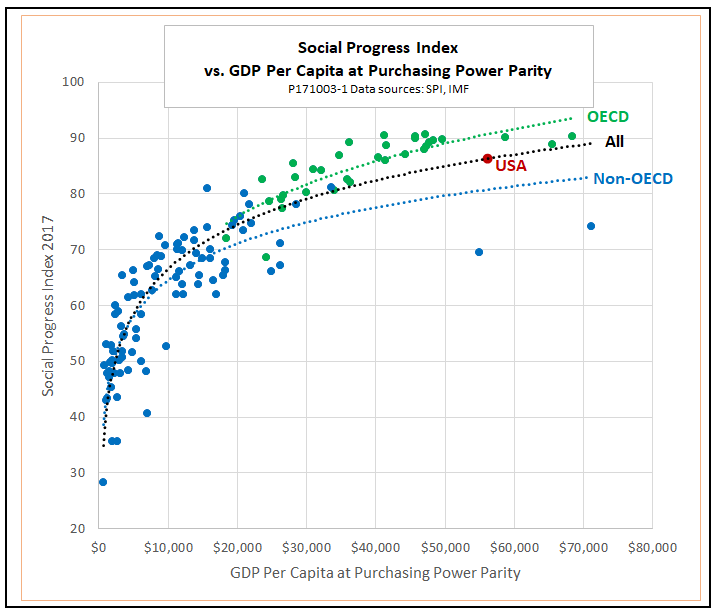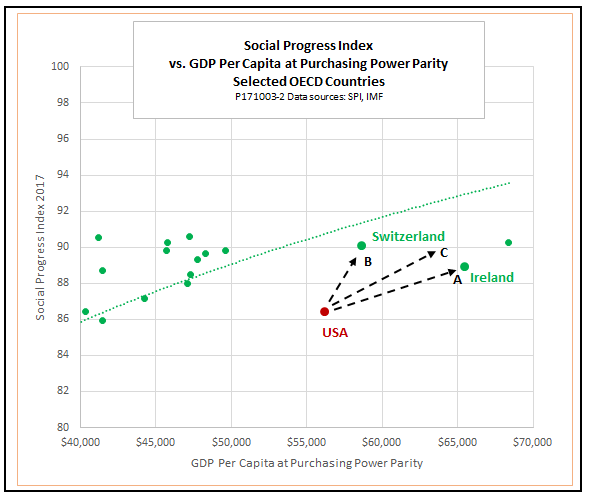Tax reform season is upon us. The White House and Congressional Republicans promise that their unified framework for tax reform will “fuel unprecedented economic growth.” The President has touted numbers as high as 6 percent. His more cautious advisers suggest 3 percent, a full percentage point or more above recent long-run forecasts. But even if faster growth were a sure thing, we need to ask whether that would bring real prosperity. Just what is real prosperity, and what would it take to achieve it?
Growth and prosperity are not the same thing
Economists use GDP as a measure of a country’s total output of goods and services that compresses output of steel, radishes, and flu shots into a single number. Although they are less widely known, it is also possible to measure the broader concept of prosperity by aggregating the many dimensions of human flourishing, including health, education, personal freedom, and living conditions, into one indicator. We expect GDP and prosperity to be positively related, but how closely?
Let’s look at some numbers. For this post, I will use the Social Progress Index (SPI) as a measure of prosperity. According to Michael Porter, Professor at the Harvard Business School and a member of the Advisory Board of the Social Progress Initiative, the SPI is “a practical tool for government and business leaders to benchmark country performance and prioritize those areas where social improvement is most needed,” and “a systematic, empirical foundation to guide strategy for inclusive growth.” (The Legatum Prosperity Index, an alternative that I have used elsewhere, would yield similar conclusions.)
The SPI is constructed from some 50 individual indicators, covering things like longevity, school enrollment, homicide rates, environmental quality, protection of property rights, freedom of religion, and many more. Despite the “progress” in its name, there is nothing especially “progressive” about it in the political sense. The great majority of its components measure aspects of human wellbeing that are equally valued by progressives, libertarians, and conservatives.
Here is a scatter plot of the SPI against GDP per capita.* The solid black trendline shows a reasonably close fit between the two variables, with an R2 of 0.82. The fit is best for a logarithmic trendline, indicating that for any given starting point, a 1 percent gain in income yields a roughly the same gain in SPI score, although a $1 gain in income has a much stronger effect for low-income countries.
The United States ranks fifth in terms of GDP per capita among the 128 countries covered by the SPI and eighteenth in terms of its social progress score. It lies exactly on the black trendline, which is plotted from data for all countries. However, that trend is pulled down by the poor SPI scores of countries like Saudi Arabia and Kuwait (conspicuous outliers in the lower right of the scatter), which suffer from the curse of riches. Compared to its real peers, the wealthy democratic countries of the OECD, the United States is an underperformer.
There does not appear to be any one group of indicators that pulls down U.S. performance down relative to global or OECD trends. We can see that by looking at some sub-groupings of the SPI indicators.
The creators of the SPI organize their indicators into three groups. Basic Human Needs includes survival-related indicators like nutrition, clean water, child mortality, and violent crime. Foundations of Wellbeing includes education, access to information, life expectancy, and environmental quality. Opportunity includes political rights, property rights, tolerance, and higher education. Compared with all countries, the United States is below the trend for basic human needs and opportunity, and close to the trend for foundations of wellbeing. Within the OECD, the U.S. is below trend in all three categories.
Instead of the SPI’s own groupings of indicators, which I find a bit quirky, we can instead reorganize them into more straightforward categories of health, education, living conditions, and personal freedoms. Among all countries, U.S. indicators are above the GDP-adjusted trend for education, on the trend for personal freedoms, and below the trend for health and living conditions. Within the OECD, U.S. performance is above trend for education and below trend for all of the other three. (Note that the education indicators in the SPI are mostly quantitative measures, such as primary, secondary, and college enrollments, rather than qualitative measures, like test scores.)
Where do we go from here?
By a variety of measures, then, the United States does not do a good job of converting raw GDP into the elements of true prosperity. Where do we go from here?
One option would be to prioritize more rapid GDP growth, as does the GOP’s unified framework for tax reform. If everything worked out for the best, growth would pick up to about three percent per year. After five years of growth at that rate, assuming no change in the position of the United States relative to the GDP-SPI trend, we would catch up with the point that Ireland occupies today. The next chart, which zooms in on the upper-right-hand corner of the preceding one, shows that outcome as Arrow A, which points to the right, parallel to the OECD trendline.
There is a possible catch, though. Backers insist the unified framework will produce enough growth to pay for promised rate reductions without increasing the deficit, but critics dispute that. The liberal-leaning Tax Policy Center estimates that the plan would reduce federal revenues by $2.4 trillion over ten years. The more conservative Committee for a Responsible Federal Budget estimates the revenue loss at $2.2 trillion.
Suppose the critics are right, and deficits widen. Suppose Congress gives in to pressures to cut support for education, public health, clean water, and environmental quality. If those programs were slashed, then, even if the promised 3 percent growth materialized, Arrow A would swing to a more south-easterly direction, significantly undershooting Ireland.
A second option would be to increase spending on social and environmental programs without fundamental structural reforms. Conservative critics would, no doubt, warn that doing so would put the brakes on growth. For the sake of discussion, suppose they were right, and GDP growth slowed to 1 percent per year. Under such a policy, the U.S. economy would travel along a path like Arrow B, with slower growth but larger gains in social prosperity. After five years, we might end up somewhere near the point representing today’s Switzerland.
Could we do even better?
If the only choices were Ireland or Switzerland, I would be tempted to aim for Switzerland. To choose otherwise, one would have to value GDP itself more highly than the better education, health, environmental quality, and personal freedom that go into the Social Progress Index. But could we do better still?
We could, if we pursued reforms that enhanced the inherent dynamism of the U.S. economy while also strengthening social and environmental protections. That combination could send our economy forward along Arrow C in the chart, aiming to the right of Switzerland and higher than Ireland. In bare outline, such a policy package might usefully include the following elements:
First, it would include genuine tax reform, as opposed to the simple tax cuts that are the likely outcome as the proposed unified framework works its way through Congress. Real tax reform would be revenue neutral. It would fully fund any cuts to top corporate and personal rates with elimination of loopholes, and without pie-in-the-sky dynamic scoring. Adding carbon taxes or consumption taxes to the mix could allow a sharp reduction in payroll tax rates, which, according to the Tax Policy Center, is a bigger burden than the income tax for three-quarters of American households.
Second, the package would include reforms of the social safety net to minimize the egregious disincentives to work that are built into today’s welfare system. I have sometimes suggested a Universal Basic Income as one way to increase work incentives, but there are many other ideas. A universal child benefit, an enhanced Earned Income Tax Credit, or an old-fashioned negative income tax also hold promise.
Third, the package would lift barriers to labor mobility that are built into our healthcare system. One critical step would be to end “job lock” by decoupling health insurance from employment. Reforms that made healthcare more portable from state to state would also help. Such reforms would simultaneously boost GDP and SPI scores.
Fourth, a comprehensive reform package would include a strong free trade policy combined with reforms that enhanced economic resilience in the face of trade and technology shocks. Healthcare and safety net reforms would contribute to shock-proofing the economy, but other measures would help too, including a rollback of excessive occupational licensing, measures like “Ban the Box” that aim to improve the job market success of ex-offenders, and measures to combat the opioid epidemic.
Tax cuts alone are not enough
The lesson here is that the even if the tax cuts in the GOP’s unified framework performed as promised, growth of GDP alone is not enough to guarantee prosperity. Instead of using growth as the be-all and end-all metric for tax policy, or any other area of policy, our primary goal should be to improve the ability of the U.S. economy to transform raw GDP into real social prosperity as measured by indicators of health, education, environmental quality, and personal freedoms. Rather than forcing economic growth for its own sake, we should focus on structural reforms that would enhance economic dynamism through improved labor mobility, reduction of work disincentives in the social safety net, and creation free markets for jobs, goods, and services both within the country and among nations.
This is not, after all, asking the impossible. Just moving up to an average level of performance, as represented by the social prosperity trendline for other wealthy, democratic countries, would be a great step forward. In fact, why be content to shoot for an Ireland or a Switzerland, which themselves are underperformers? Why not aim for the above-trend standards of a Denmark, a Finland, or a New Zealand? Why not try, at least?
____________________
*The SPI data are from the 2017 release of the index, which contains the most recent available value of each variable for each country. The average data year for the 2017 release is 2015. Accordingly, I have used 2015 values of GDP per capita, measured at purchasing power parity, downloaded from the IMF data base.

